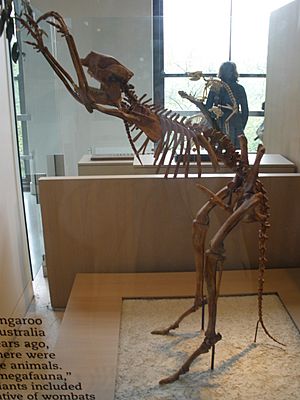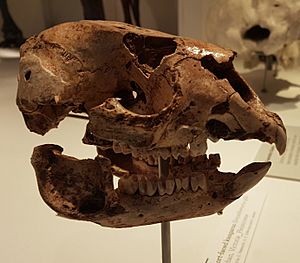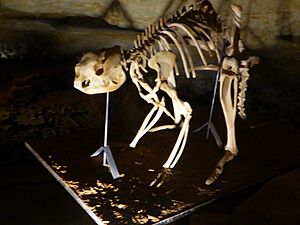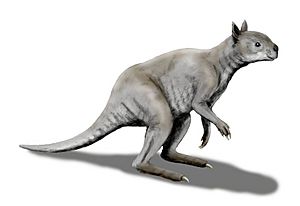Simosthenurus facts for kids
Quick facts for kids SimosthenurusTemporal range: Pleistocene
|
|
|---|---|
 |
|
| S. occidentalis skeleton at American Museum of Natural History | |
| Scientific classification |
|
| Kingdom: | Animalia |
| Phylum: | Chordata |
| Class: | Mammalia |
| Infraclass: | Marsupialia |
| Order: | Diprotodontia |
| Family: | Macropodidae |
| Genus: | †Simosthenurus Tedford, 1966 |
| Species | |
|
S. maddocki |
|
Simosthenurus, also known as the short-faced kangaroo, was an ancient type of large kangaroo. It lived in Australia, including Tasmania, a long time ago during the Ice Age. Scientists call this time the Pleistocene period.
Even though it looked a bit like today's kangaroos, Simosthenurus was very different. It was part of a group of large animals called "megafauna" that are now extinct. The most well-known types of Simosthenurus are S. maddocki and S. occidentalis.
Contents
What Was Simosthenurus Like?
Scientists have learned a lot about Simosthenurus by studying its bones, often found in caves. These bones show that it was related to modern kangaroos. But there was a big difference in how they moved!
Modern kangaroos hop on two legs, pushing off the ground with their feet. Simosthenurus walked on two legs, more like humans do. It had strong, heavy bones, a wide hip area, long arms, and short necks. These features helped it eat leaves from trees and bushes. Its back feet had small, hoof-like nails, which were good for walking on flat ground.
Simosthenurus was a special kind of kangaroo that has no living relatives today. Its closest living cousin might be the banded hare-wallaby, which now lives on small islands off Western Australia.
S. occidentalis
S. occidentalis was a leaf-eating marsupial. It was about the same height as a modern grey kangaroo but much stronger and heavier. An adult S. occidentalis could weigh around 118 kilograms (about 260 pounds).
Scientists believe this species walked slowly on two legs. Modern kangaroos, when moving slowly, often use their tail and front paws to help them move their back legs forward. But S. occidentalis seemed to walk upright. It probably stood on its back legs and used its long arms and fingers to pull down high leaves and branches. Then, it would use its powerful jaws and special teeth to grind up the tough leaves.
Fossils of S. occidentalis found in Tasmanian caves are very old, dating back between 46,000 and 50,000 years ago.
S. maddocki
S. maddocki was smaller than S. occidentalis, weighing about 78 kilograms (about 172 pounds). This species was very picky about what it ate.
Fossils of S. maddocki are not as common as other ancient kangaroos. Most of its fossils have been found in southeastern Australia.
Why Did Simosthenurus Disappear?


Scientists have a few ideas about why Simosthenurus and other large animals went extinct. The two main ideas are human activity and climate change.
Human Impact
One idea is that humans caused their extinction. Humans arrived in mainland Australia first, and there are fewer extinct large animals in Tasmania compared to the mainland. This suggests that humans might have played a role. It's possible that people hunted Simosthenurus too much, or changed its habitat. However, there isn't much evidence that humans and Simosthenurus lived together for a long time.
Climate Change
Another idea is that changes in the climate led to their disappearance. The last Ice Age brought very cold and dry conditions. This big change in weather might have made it hard for Simosthenurus to find enough food or survive. Many large animal populations, including Simosthenurus, decreased during this time.
See also
 In Spanish: Simosthenurus para niños
In Spanish: Simosthenurus para niños


